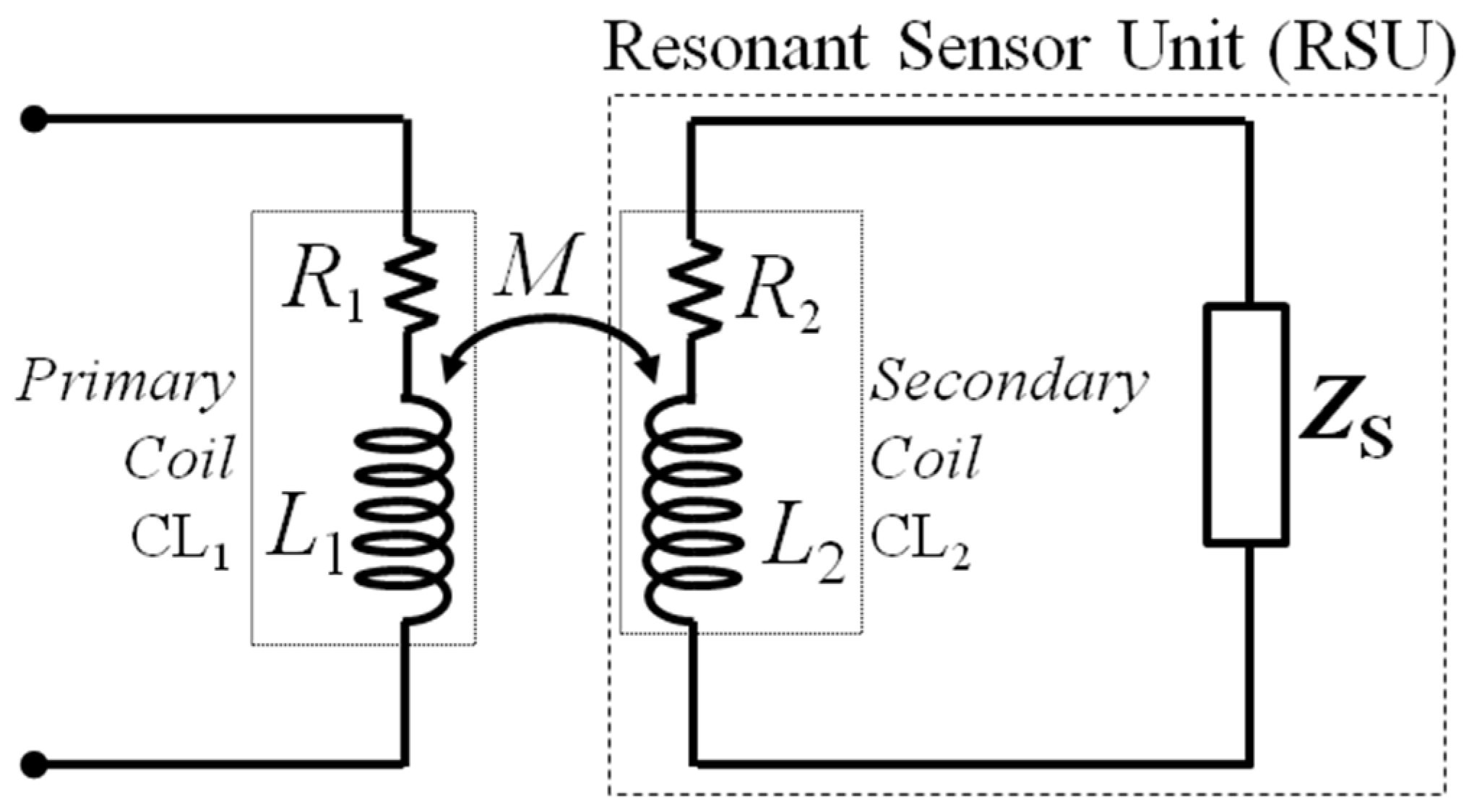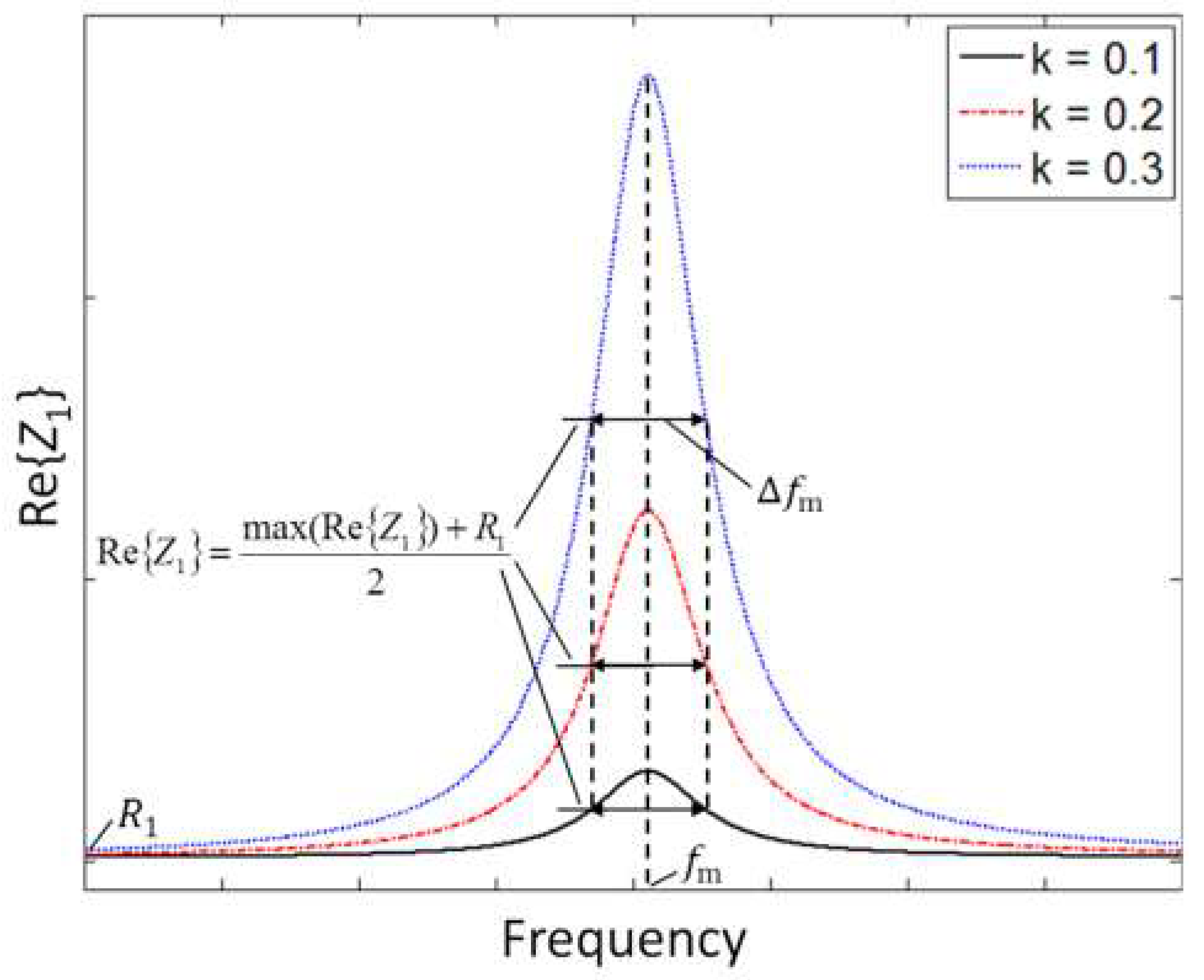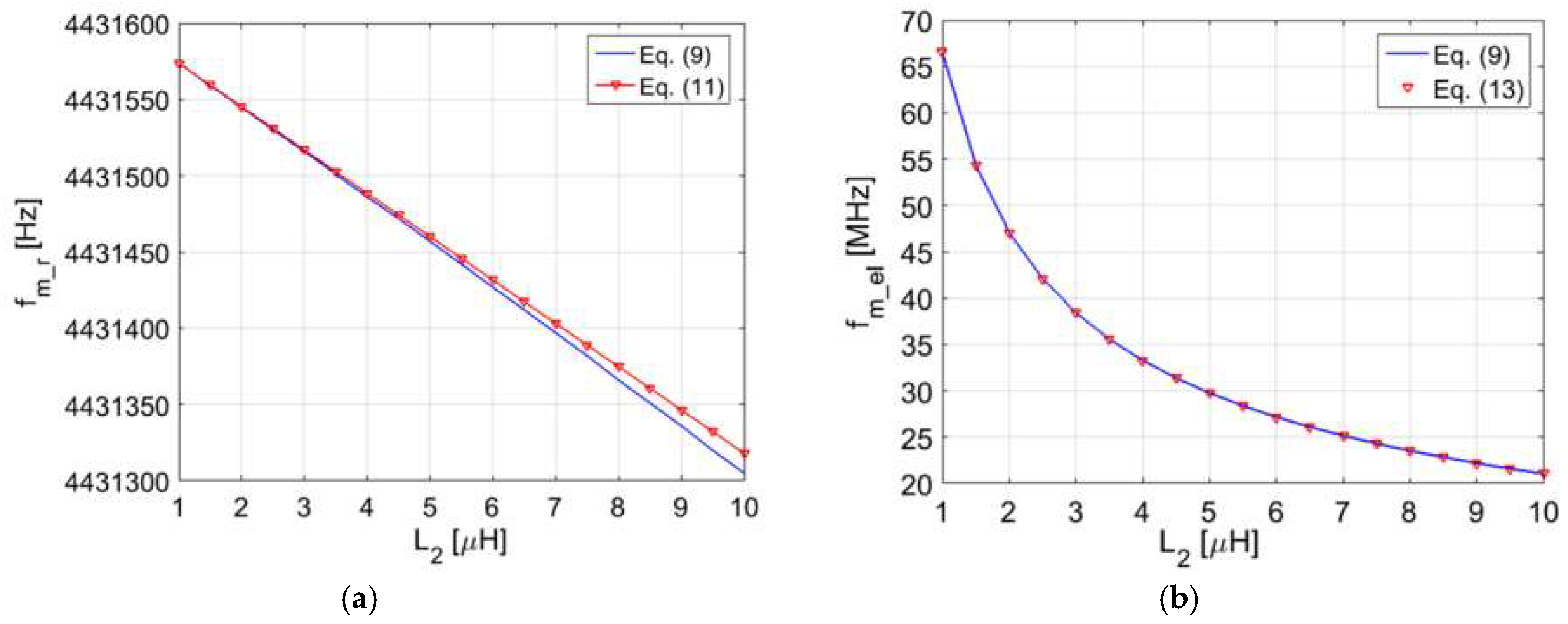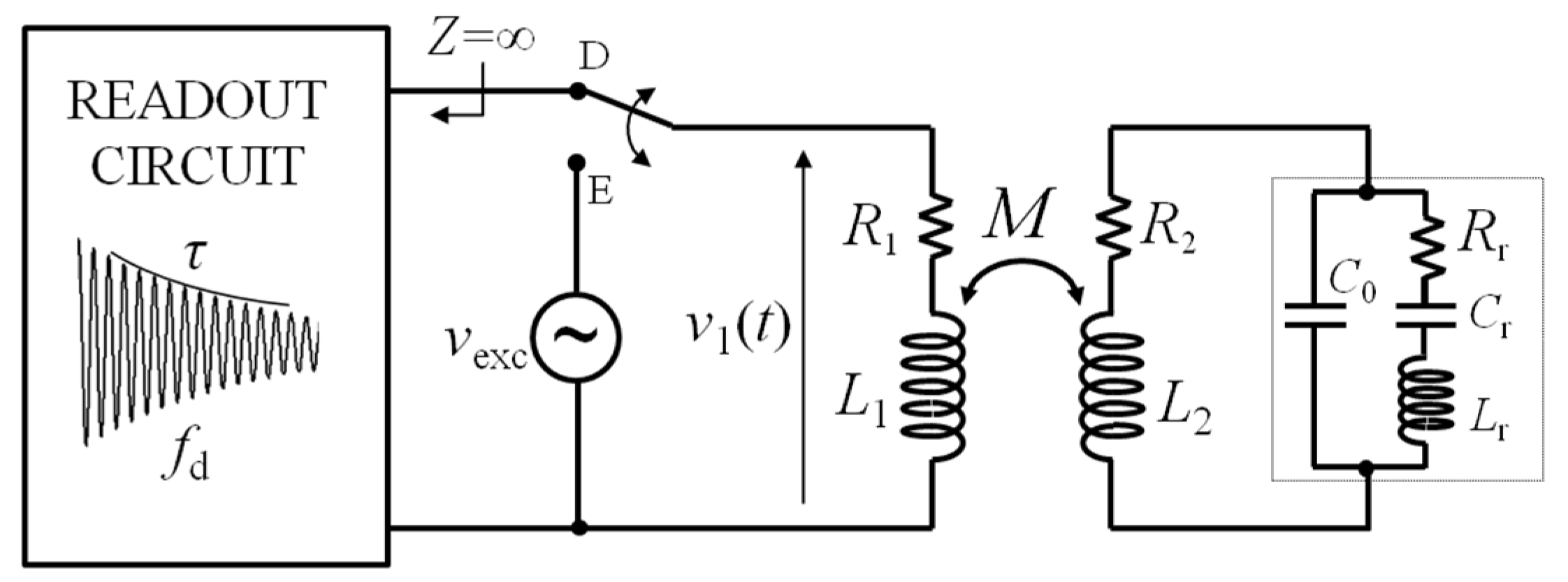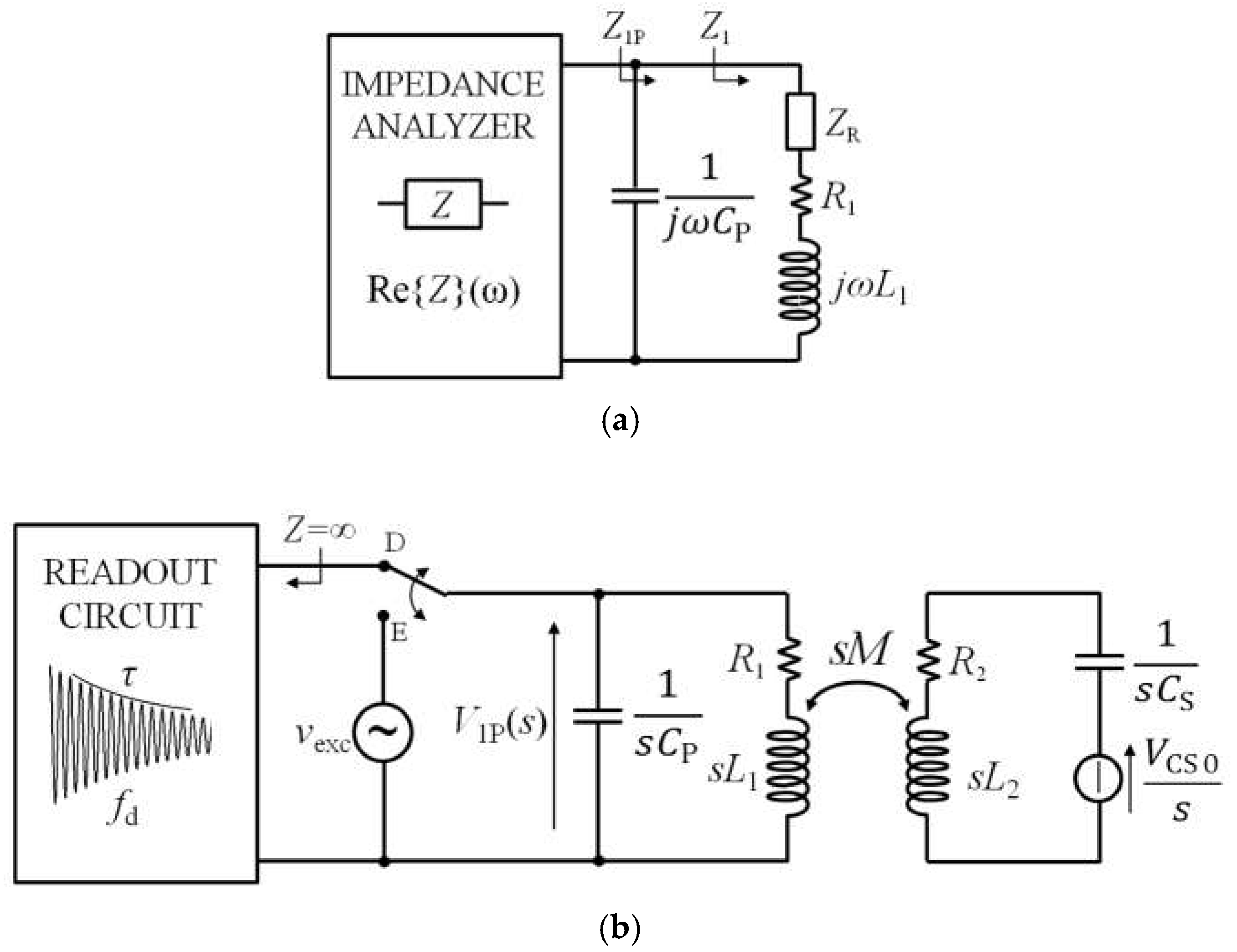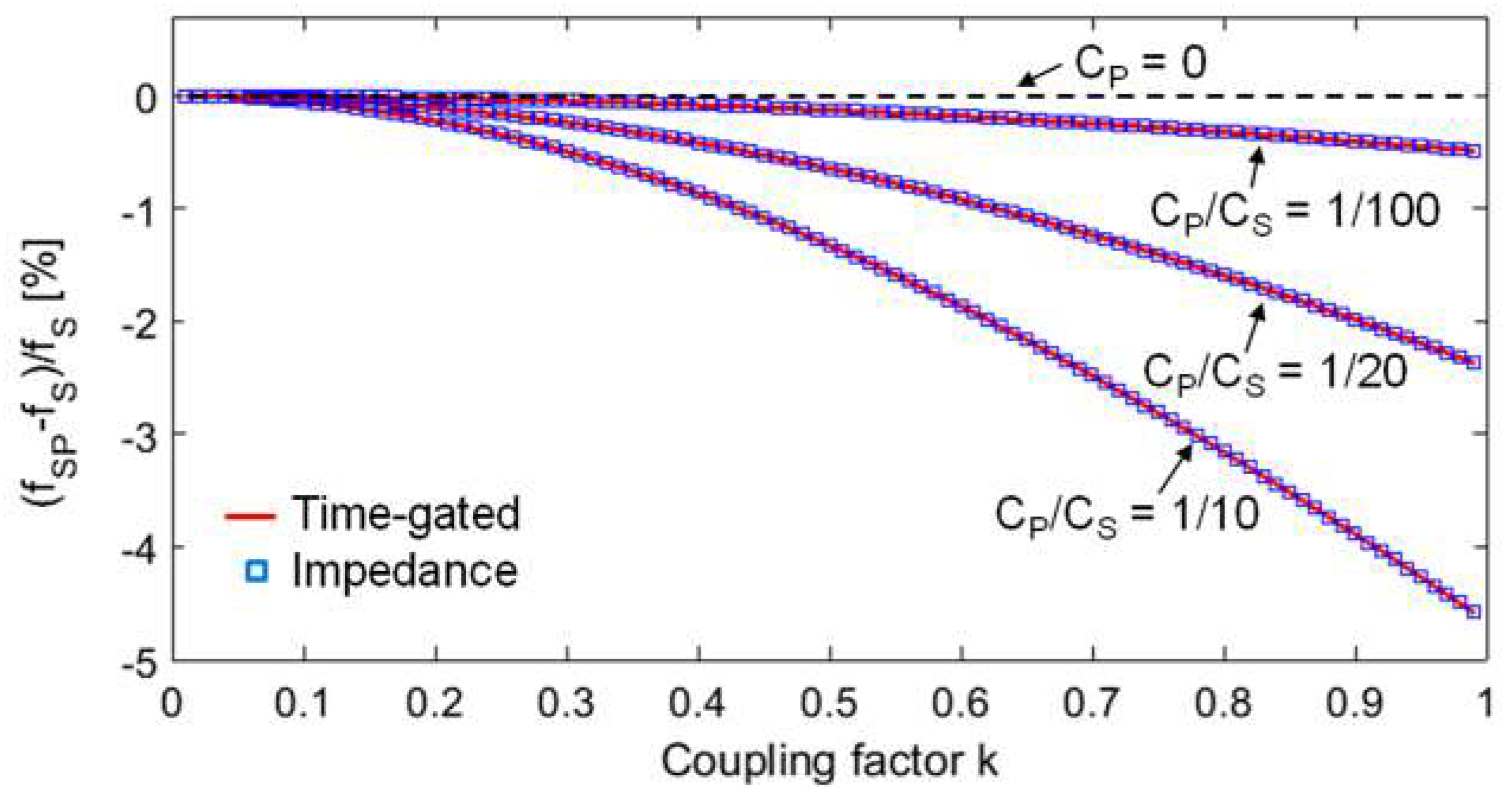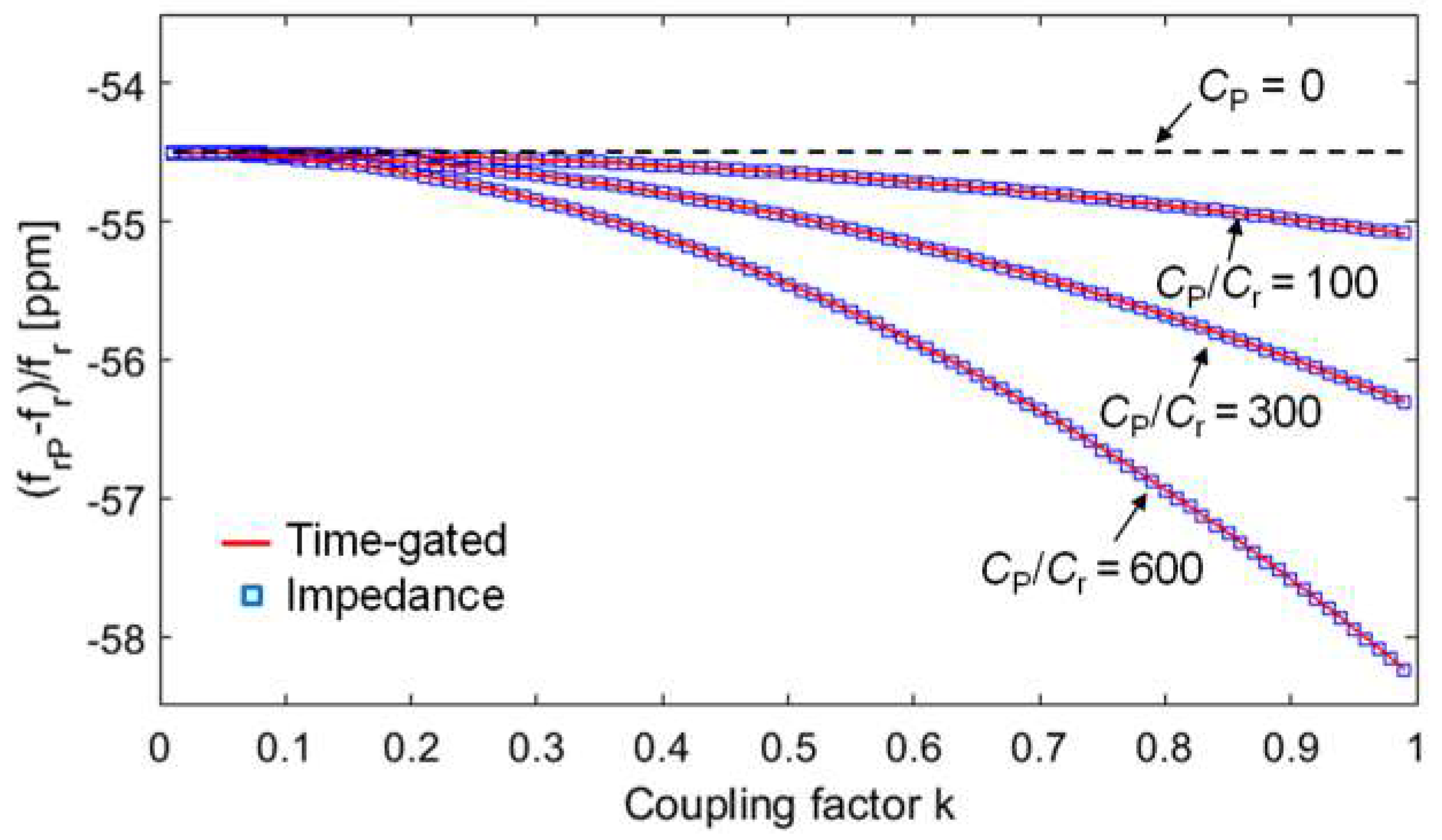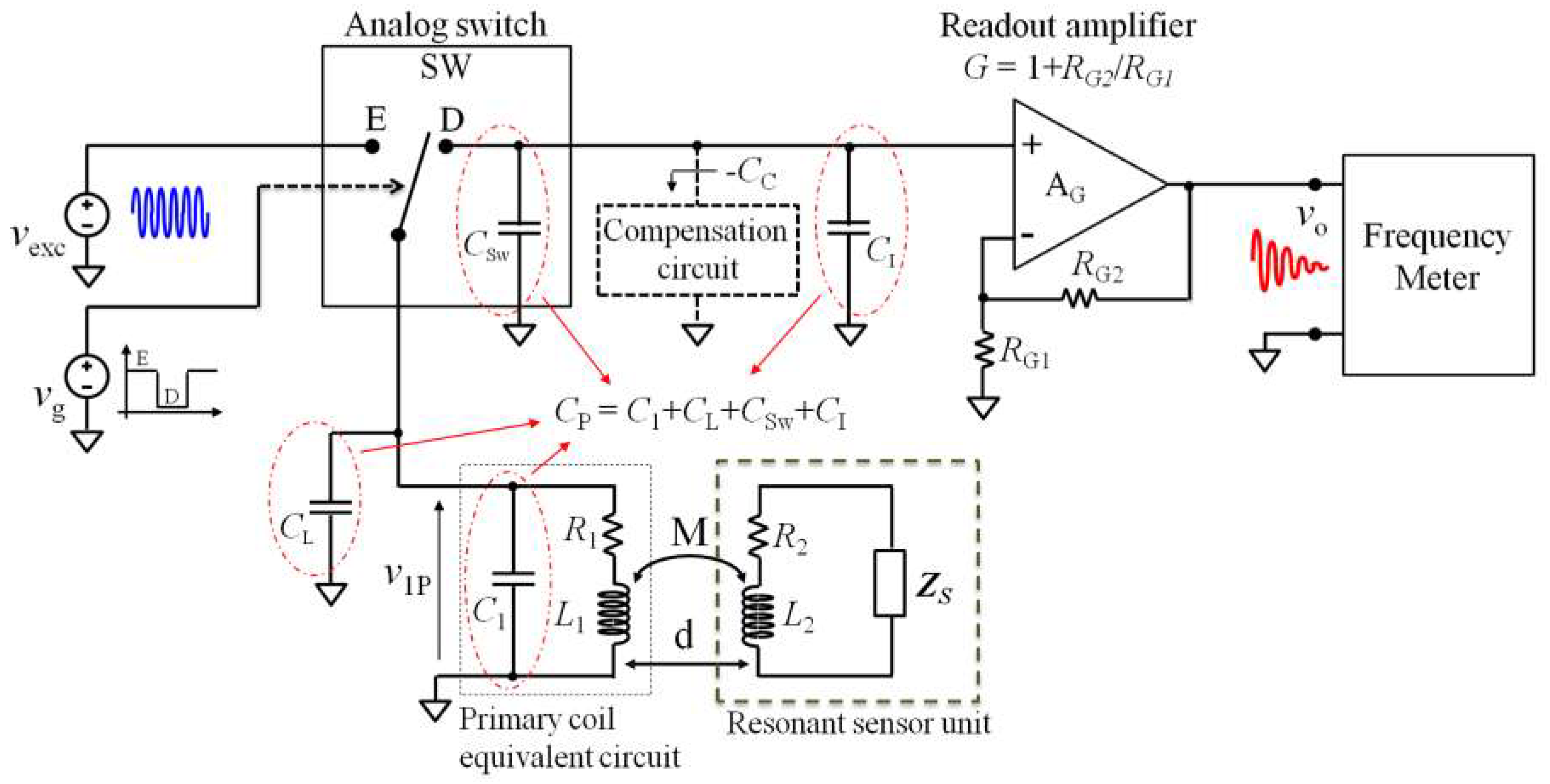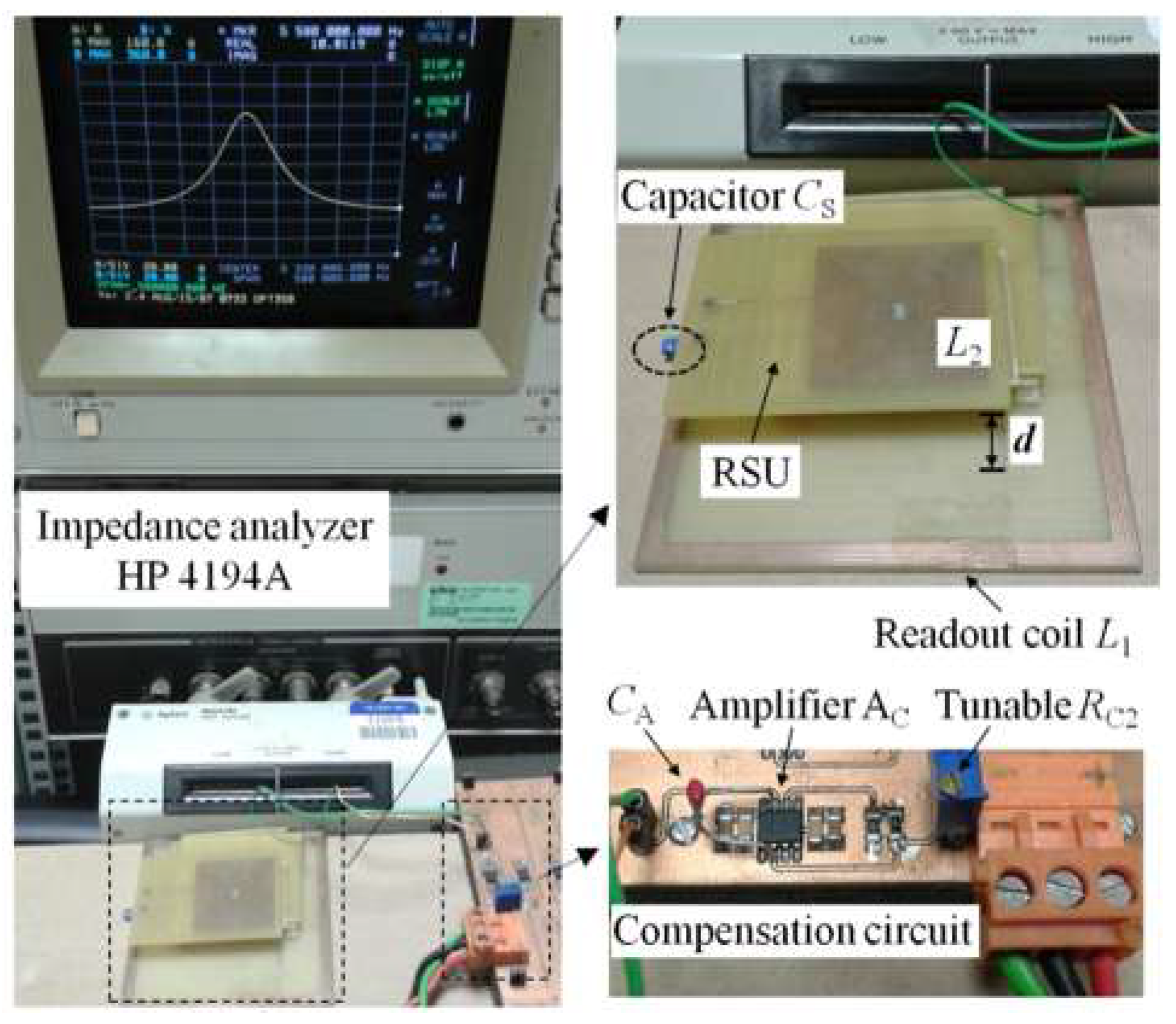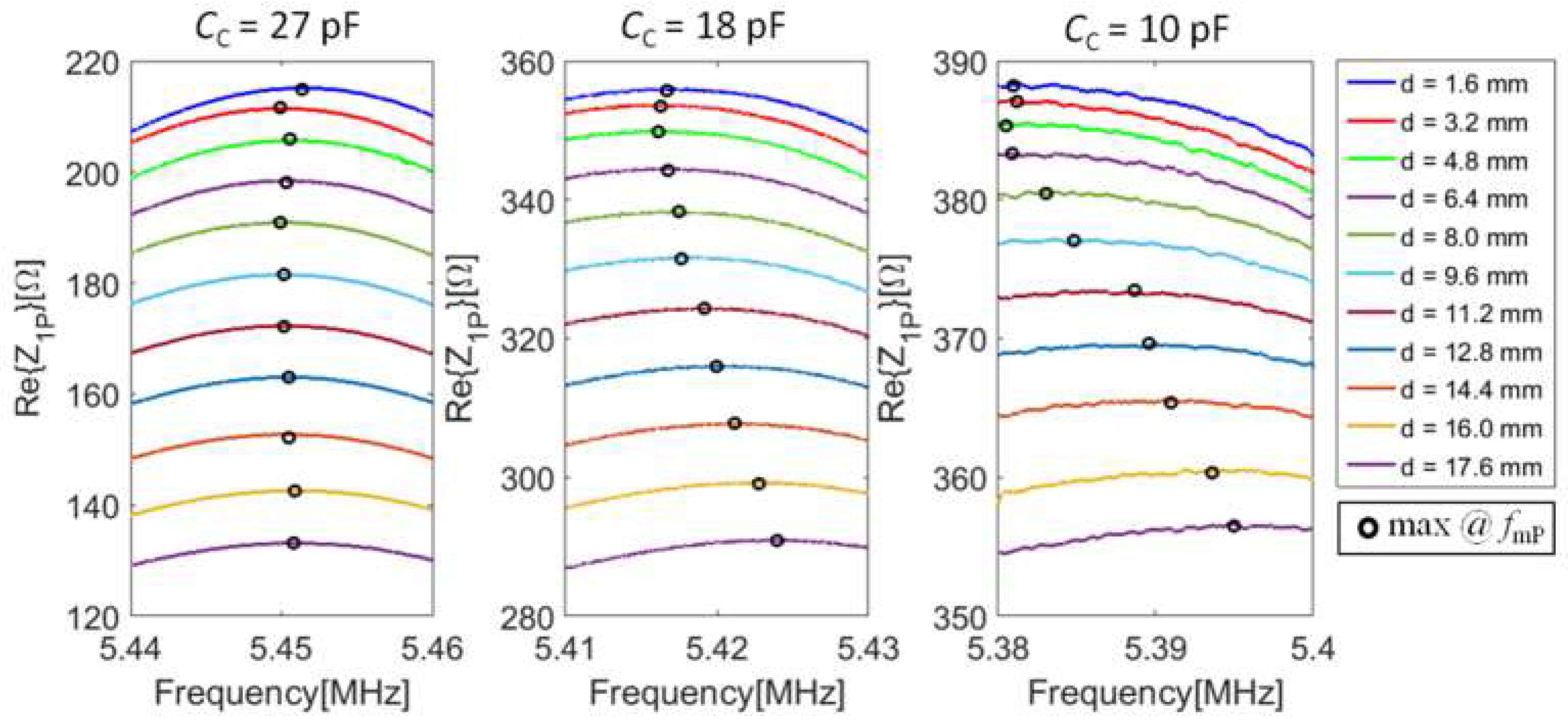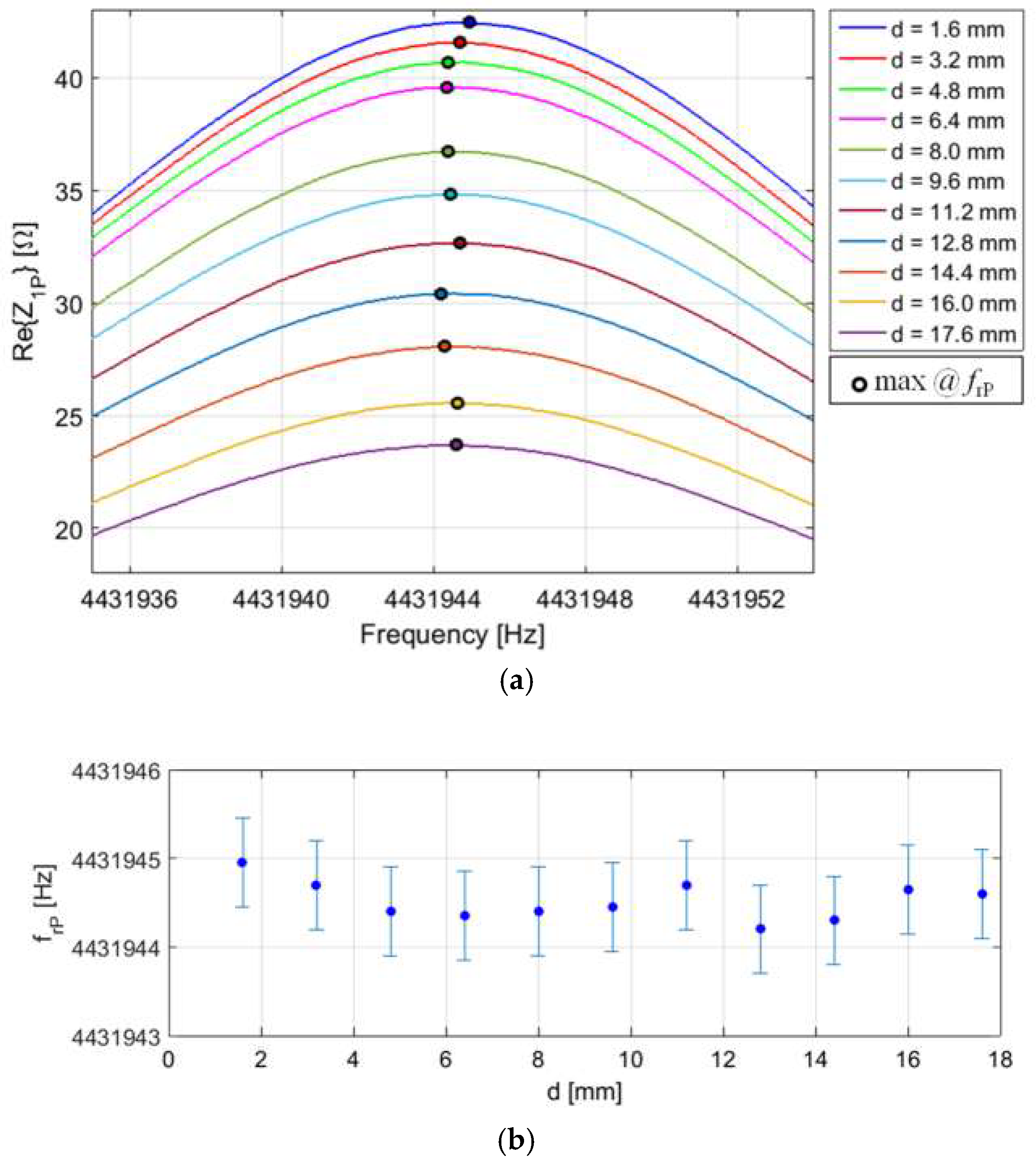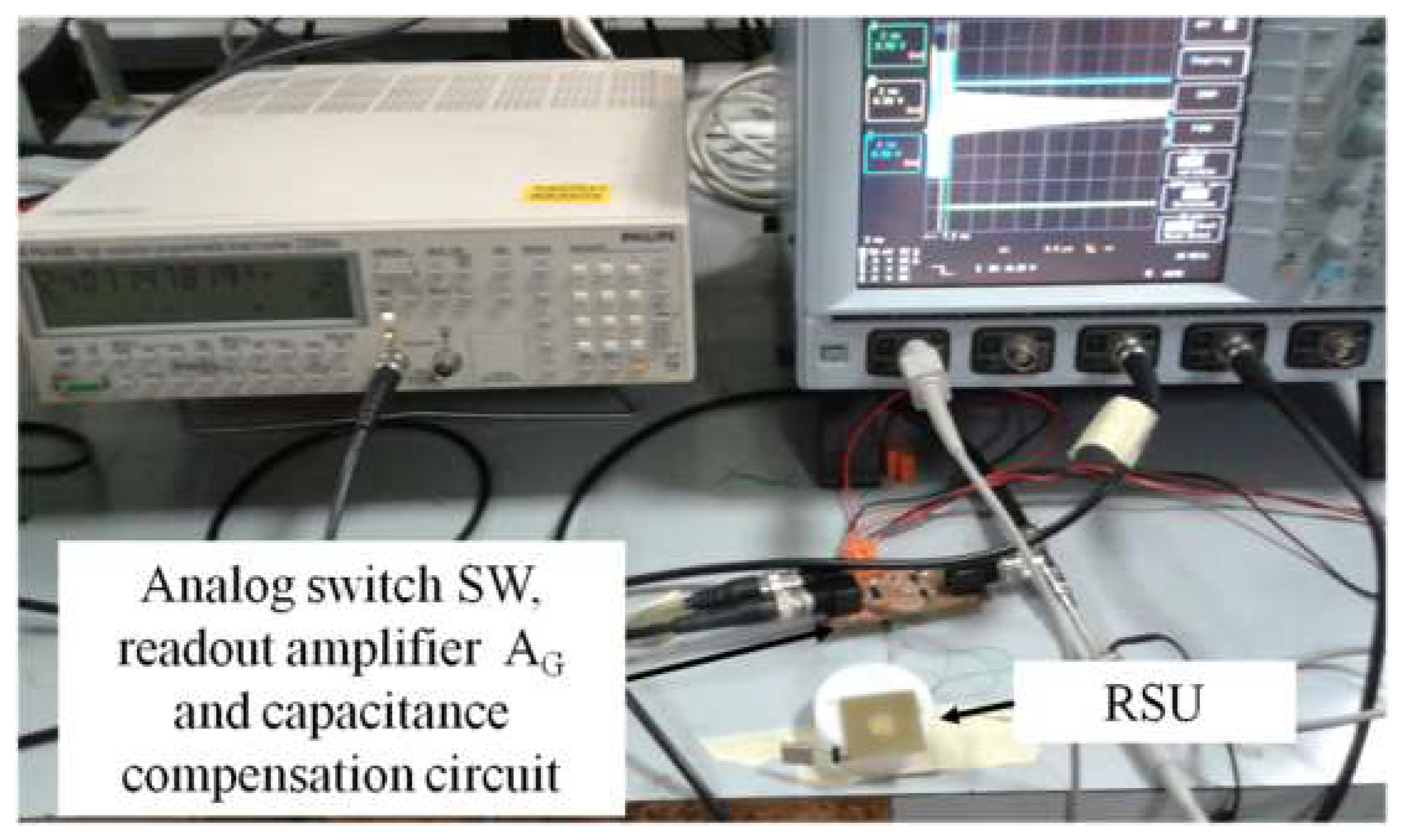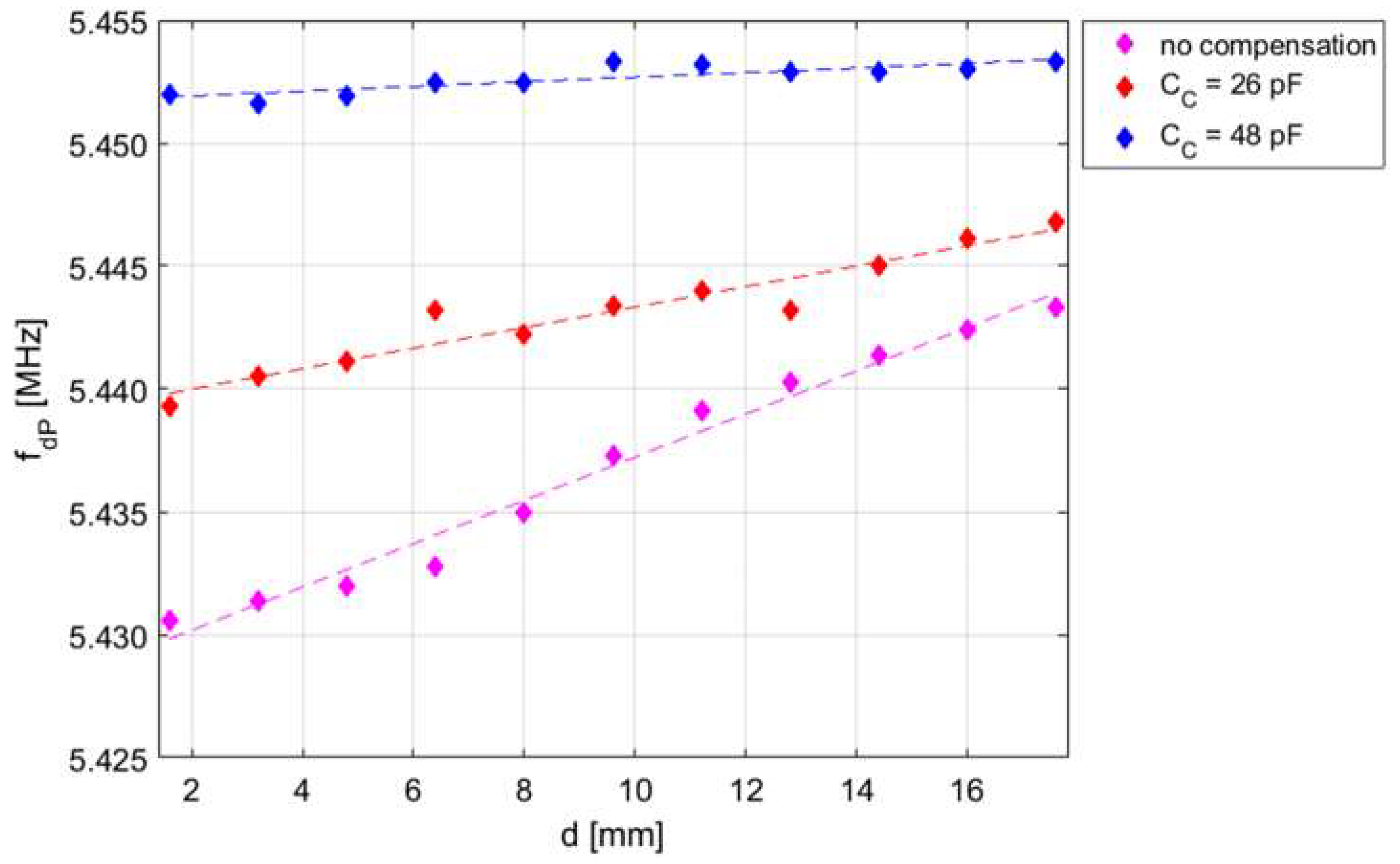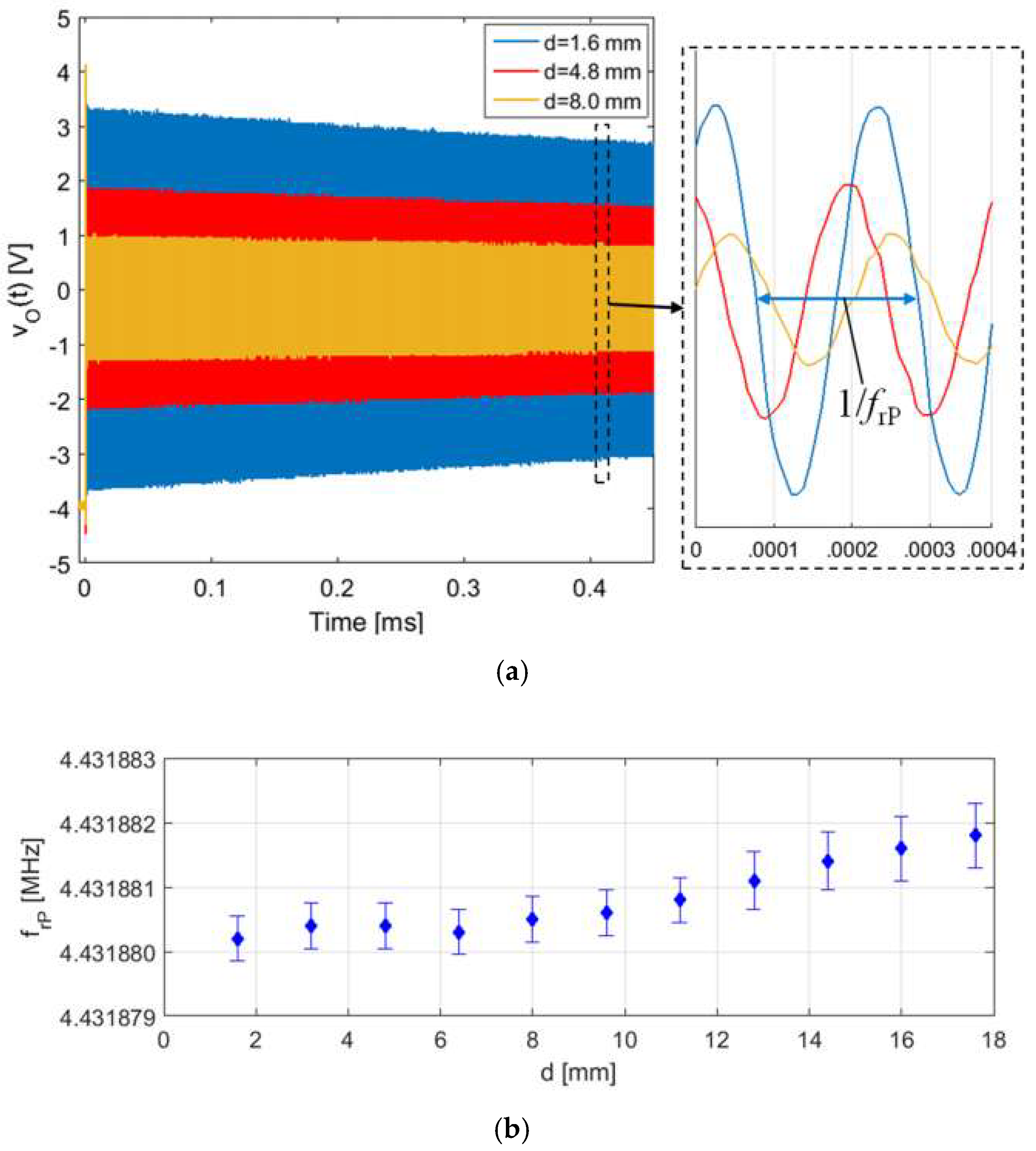3.1. General Considerations
Specific interrogation techniques are required to extract information from the RSU through electronic measurements at the primary coil, exploiting the advantage of coil-coupled, i.e., contactless, operation.
One major issue to consider is the dependence of the mutual inductance
M and coupling factor
k of the coils on geometrical parameters, such as their distance, alignment, and relative orientation. Techniques that are influenced by the value of
M, or equivalently
k, would require keeping such geometrical parameters fixed and constant [
27,
28]. On the other hand, in most practical applications, keeping the distance and the alignment between coils fixed is unpractical/unfeasible. Therefore, as a key requirement for out-of-the-lab use of coil-coupled sensors, robust measurement techniques are demanded that are independent of
k.
In the following, two innovative techniques are illustrated to perform k-independent readout of RSUs of both capacitance and electromechanical piezoelectric resonator types. In particular, the first is a frequency-domain technique which relies on the measurement of the reflected impedance at CL1. The second is a time-domain technique, termed time-gated technique, which considers the free damped response of the RSU measured at the primary coil after that the RSU has been energized.
3.2. k-Independent Techniques Applied to Coil-Coupled Capacitance Sensors
Figure 3a shows the block diagram of the readout technique based on impedance measurements, where the readout system consists in an impedance analyzer connected to the primary coil CL
1. From the equivalent circuit of
Figure 3b, the impedance
Z1, as a function of
ω = 2π
f, is
It can be seen from Equation (3) that the effect of the coupling with the RSU results in a reflected impedance
ZR in series with the primary coil that makes the total impedance
Z1 dependent on the coupling factor
k. Nevertheless, the resonant frequency
fS and the quality factor
QS of the RSU, defined in Equation (1), can be obtained from the real part of
Z1 [
20], given by
Re{
Z1} has a local maximum at the frequency
fm =
ωm/2π, which can be found by equating to zero the derivative of Equation (4) with respect to ω. Interestingly enough,
fm is independent of
k, and it can be related to
fS and
QS only. Then, combining Equations (1) and (4), the following relations hold:
where Δ
fm is the full width at half maximum (FWHM) of Re{
Z1}, around
fm [
20]. If
QS is sufficiently large, then
fm ≈
fS, with a relative deviation |
fm −
fS|/
fS < 100 ppm for
QS > 50. Equations (4) and (5) demonstrate that from the measurement of
fm and Δ
fm in Re{
Z1}, the frequency
fS and quality factor
QS of the capacitive RSU can be advantageously extracted independently from
k.
Figure 4 shows sample plots of Re{
Z1} calculated for three different values of
k, and illustrates the definition of Δ
fm. Consistently with Equation (4),
k only affects amplitude.
The operating principle of the time-gated technique is shown in
Figure 5a [
21]. It comprises two subsequent alternating phases, namely, excitation and detection phases. During the excitation phase, when the switch is in the E position, CL
1 is connected to the sinusoidal signal
vexc(
t) to excite the RSU through inductive coupling. During the subsequent detection phase, when the switch is in the D position, the excitation signal is disconnected, and CL
1 is connected to a readout circuit with a high-impedance input, resulting in a virtually zero current in CL
1.
The input voltage v1(t) of the readout circuit during the detection phase D can be derived by taking the inverse Laplace transform of the corresponding voltage V1(s), where s is the complex frequency. Since the RSU forms a second order LCR network, the voltage v1(t) is expected to be a damped sinusoid with frequency fd and a decay time τd from which the resonant frequency fS and the quality factor QS of the RSU can be inferred.
Generally, assuming that the detection phase D starts at t = 0, the readout voltage v1(t) depends on the initial conditions at t = 0 of all the reactive elements, namely CS, L1, L2, and M. The effect of the initial conditions on v1(t) for t > 0 is to globally affect only its starting amplitude, while the complex frequencies of the network, that define fd and τd, are unaltered. Therefore, without losing any generality, the single initial condition VCS0 defined as the voltage across CS at t = 0 can be considered, neglecting the remaining ones. As an equivalent alternative that does not change the consequences of the present treatment, VCS0 can also be seen as an effective initial condition.
As a result, the equivalent circuit of
Figure 5b representing the time-gated configuration during the detection phase in the Laplace domain can be considered, and the expression of
V1(
s) is
The corresponding time expression
v1(
t) can be calculated:
The signal
v1(
t) is a damped sinusoid with damped frequency
fd and decay time
τd that are related to
fS and
QS of the RSU as
If
QS is sufficiently large, it results in
fd ≈
fS, with a relative deviation |
fd −
fS|/
fS < 50 ppm for
QS > 50. Notably, the coupling factor
k only acts as an amplitude factor on
v1(
t) without influencing either
fd or
τd.
Figure 6 reports sample plots of
v1(
t) calculated for three different values of
k.
In summary, Equations (7) and (8) demonstrate that, under the assumptions made, the time-gated technique can also allow extraction of the frequency fS and quality factor QS of the capacitive RSU, independently of k.
3.3. k-Independent Techniques Applied to Coil-Coupled Electromechanical Piezoelectric Resonators
Considering the technique based on impedance measurements with reference to the equivalent circuit of
Figure 2b, the impedance
Z1 measured at the primary coil can be expressed as
As it can be observed in Equation (9), the impedance Z1 depends on the coupling factor k. Nevertheless, also in this case, the frequency fr can be extracted from the frequency of the maximum of the real part of Z1.
Close to the angular frequency
ωr = 2π
fr, the impedance of the motional arm Z
r =
Rr +
jωLr + 1/(
jωCr) has a magnitude typically much smaller than that of the impedance of
C0, i.e., |Z
r| << 1/
ωC0. Then, the presence of
C0 can be neglected, resulting in the simplified equivalent circuit of
Figure 7a. Accordingly, Re{
Z1} around
ωr has the following approximated expression:
Equation (10) has the same form as Equation (4) and, hence, Re{
Z1} has a maximum at the frequency
fm_r given by
It can be observed that for large Qr2, fm_r ≈ fr2 with a deviation |fm_r − fr2|/fr2 < 100 ppm for Qr2 > 50. In addition, assuming that L2 << Lr, the frequency fr2 approximates fr and, hence, fm_r ≈ fr holds. Similarly, if R2 << Rr, Qr2 approaches Qr. Importantly, again, the coupling factor k acts only as an amplitude factor that advantageously does not affect either the frequency or the quality factor of the resonance.
Considering, now, the frequencies
ω >>
ωr, the impedance magnitude of
C0 is smaller than the impedance magnitude of
Zr, which then can be neglected, obtaining the equivalent circuit of
Figure 7b. Consequently, the following approximated expression of Re{
Z1} results:
Also Equation (12) has the same form as Equation (4), and it can be seen that Re{
Z1} now has a maximum at the frequency
fm_el:
From the previous analysis, it can be concluded that Re{Z1} has two peaks: the first is related to the mechanical resonance fr, the second to the electrical resonance fel. With the previous assumptions on the values of Lr and L2, and considering that, typically, Cr << C0, then it follows that fel >> fr.
To validate, numerically, the proposed approximations,
Figure 8a,b report the comparison of the values of
fm_r and
fm_el derived respectively from Equations (11) and (13), and the frequency of the maxima derived numerically from Re{
Z1} in Equation (9) as a function of
L2. The following values of the BVD model of a 4.432 MHz AT-cut QCR have been used:
C0 = 5.72 pF,
Rr = 10.09 Ω,
Lr = 77.98 mH, and
Cr = 16.54 fF. For CL
1 and CL
2, the values of the electrical parameters are
L1 = 8.5 µH,
R1 = 5 Ω, and
R2 = 5 Ω.
Figure 8a shows that for
L2 up to 10 µH, the values of
fm_r predicted from Equation (11) are within 3 ppm with respect to the numerical solutions from Equation (9). Additionally, for the same range of variation of
L2, a remarkable agreement is obtained between
fm_el predicted from Equation (13) and the numerical solution.
The possibility to interrogate coil-coupled electromechanical piezoelectric resonators with the time-gated technique independently from the coupling has been previously demonstrated [
21].
The RSU configuration of
Figure 9 has been studied in [
21], showing that the open circuit voltage
v1(
t) at CL
1 during the detection phase, after the RSU has been energized in the excitation phase, is the sum of two damped sinusoids: one at frequency
fd_r with exponential decaying time
τr, and one at frequency
fd_el with exponential decaying time
τel.
The damped sinusoid at
fd_r is due to the mechanical response of the resonator, while the one at
fd_el is due to the electrical response of
L2 that interacts with the electrical capacitance
C0. In addition, for suitable values of
L2 and
R2, and considering the typical values of the equivalent parameters of the BVD model of a QCR, the decaying time
τr is orders of magnitude larger than
τel. Thus, the damped sinusoid at frequency
fd_el decays to zero much faster than the damped sinusoid at frequency
fd_r. Hence, the former can be neglected in the expression of
v1(
t), which results in
where the amplitude and phase coefficients
Ar and
θr are functions of both the initial conditions at the beginning of the detection phase (
t = 0), and the electrical and mechanical parameters of the system. The last term represents the contribution of the initial current
iL1(0) in the primary inductor. From Equation (14), it can be seen that
k acts only as a scaling factor for the amplitude of
v1, without affecting the sensor response parameters
fd_r and
τr. From a simplified analysis that considers the undamped system with
R2 = 0 and
Rr = 0, under the hypothesis that (
ωC0)
−1 >>
ωL2 at the frequency
fr and that
Qr is large, it has been obtained that the frequency
fd_r can be approximated with the following relation:
It can be observed in Equation (15) that
fd_r depends on the ratio between
L2 and
Lr. Nevertheless, if
L2 <<
Lr the frequency
fd_r tends to the resonant frequency
fr of the electromechanical resonator. A numerical analysis that allows the calculation of the parameters
fd_r and
τr of the complete system, is also reported in [
21]. The results can be directly compared with
Figure 8, the values of the parameters of the BVD model used in the numerical analysis being the same. Also in that case, good agreement between the values of
fd_r predicted from Equation (15) and the numerical results have been obtained, with a maximum deviation within 3 ppm for
L2 up to 10 µH.
3.4. Effect of Parasitic Capacitance at the Primary Coil on Coil-Coupled Capacitance Sensors
When the proposed techniques are transferred into real electronic circuits, unavoidable nonidealities result in a lumped parasitic capacitance CP that appears in parallel to L1. The parasitic capacitance CP is mainly composed of the parasitic capacitance of the inductor L1, the capacitance of the connections, and the input capacitance of the electronic interface.
The effect of
CP is now evaluated, firstly, considering the case of the RSU with the capacitance sensor, extending the treatment of
Section 3.2.
With reference to
Figure 10a, the real part of the impedance at the primary coil becomes
As discussed in [
23], with
CP ≠ 0, Equation (16) no longer allows extraction of
fS and
QS independently from the coupling factor
k, which now is in the expression of
Z1P and affects Re{
Z1P}, not only as a scaling factor. In particular, it has been shown by a numerical analysis of Equation (16) that Re{
Z1P} has two maxima, corresponding, respectively, to a primary resonance near
fS and a secondary resonance near
. Both the frequencies of the maxima and the trend of Re{
Z1P} are influenced by the coupling factor
k [
23].
Considering now the time-gated technique, the voltage
v1P(
t) at the primary coil in the detection phase can be obtained from the circuit of
Figure 10b. Adopting the same approach as for the case of
CP = 0, it will be assumed that all the reactive elements, except the capacitor
CS, have zero initial conditions at
t = 0. Consequently, the voltage
V1P(s) can be expressed in the Laplace domain as
where
VCS0 is the voltage across
CS at
t = 0. From Equation (17), it can be seen that
k, besides acting as a scaling factor, also features in the coefficient of fourth degree in the polynomial
D(
s). Consequently, it is expected that the complex frequencies are dependent on
k. Taking the inverse Laplace transform of Equation (17), it results that the expression of
v1P(
t) is composed of the sum of two damped sinusoids as
where
A1 and
A2 are amplitude coefficients and
θ1 and
θ2 are phase angles that depend on the parameters of the circuit and the initial conditions. The frequencies
fd1 and
fd2 and the decay times,
τd1 and
τd2 are obtained by the complex conjugate solutions
p1,2 = 1/
τd1 ± j2π
fd1 and
p3,4 = 1/
τd2 ± j2π
fd2 of
D(
s) = 0.
From the values of p1,2 and p3,4, it can be demonstrated that fd1 is close to fP, while fd2 is close to fS, but both fd1 and fd2 are dependent on k. For R2 sufficiently smaller than R1, a decay time τd2 larger than τd1 can be obtained. In this condition, in v1P(t) the damped sinusoid at fd1 falls off more rapidly than that at fd2, and it becomes negligible as time elapses. Importantly, since fd2 depends on k, the distance-independent operation of the case CP = 0 is now lost.
The dependence of the readout frequency on the coupling factor k, introduced by the parasitic capacitance CP, on both the proposed techniques, is investigated by numerical analysis. For the RSU and CL1, the following sample values, which represent real conditions well, have been considered: L2 = 8 µH, CS = 100 pF, R2 = 3 Ω, L1 = L2, and R1 = 10 Ω. For the impedance technique, the frequency fSP has been calculated from the expression of Re{Z1P}, adopting the definitions in Equation (5). For the time-gated technique, fSP has been calculated from fd2 and τd2, derived from the numerical solution of D(s) = 0, adopting the definitions in Equation (8).
Figure 11 compares the obtained relative deviation (
fSP −
fS)/
fS as a function of the coupling factor
k for three different values of
CP/CS. For the considered values of the parameters,
CP ranges from 1 pF to 10 pF. As it can be observed, (
fSP −
fS)/
fS deviates from zero, corresponding to
CP = 0. The deviation increases for increasing
k of an amount that augments with
CP/CS. Noticeably, both the techniques are equally affected by the inaccuracies introduced by
CP, in terms of the dependence of the readout frequency on
k. These results demonstrate that
CP prevents accurate distance-independent measurements from being obtained.
3.5. Effect of Parasitic Capacitance at the Primary Coil on Coil-Coupled Electromechanical Piezoelectric Resonators
Considering, now, the case with coil-coupled electromechanical piezoelectric resonators, the dependence on
k due to
CP can be evaluated by using the same numerical approach as discussed in
Section 3.3. The resonant frequency
frP can be obtained from numerical analysis of the equivalent circuit in
Figure 12a for the frequency-domain technique based on impedance
Z1P, while the equivalent circuit of
Figure 12b must be considered for the time-gated technique to determine
V1P(
s).
In both the equivalent circuits, the impedance of the static capacitance C0 has been considered high enough to be neglected. For the time-gated technique, CP is expected to give rise to an additional damped sinusoid in v1P(t), with a damped frequency related to CP resonating with L1. However, the numerical simulations have demonstrated that this sinusoid fades out more quickly than the damped sinusoid, due to the QCR response.
Considering the same parameter values for the QCR as adopted for the analysis of
Figure 8, the obtained relative deviation (
frP −
fr)/
fr as a function of
k for three different increasing values of the ratio
CP/C
r, is reported in
Figure 13. For the considered values of the parameters, C
P ranges from 1.65 pF to 99.2 pF. The baseline, i.e., the dotted curve corresponding to
CP = 0, is at −54.5 ppm because of
L2, that slightly affects
fr2 and, hence,
frP, according to Equation (11). As it can be observed,
frP has a maximum variation of less than 4 ppm with respect to the baseline. Remarkably, also in this case, the same behaviour with respect to
CP and
k is predicted for the two techniques.
The quantitatively negligible dependence of frP on k can be ascribed to the fact that the inductive component in the RSU is dominated by Lr. In fact, Lr is three orders of magnitude larger than L2, and it is not involved in the coupling between the primary coil and the RSU. This result shows that with coil-coupled electromechanical resonators, such as QCRs, the proposed techniques remain practically independent from the coupling factor k, despite a not-negligible CP.
